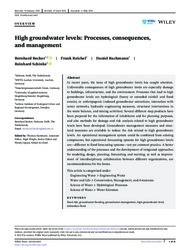High groundwater levels: Processes, consequences, and management
DOI: https://doi.org/10.1002/wat2.1605
Persistent URL: http://resolver.sub.uni-goettingen.de/purl?gldocs-11858/10245
Persistent URL: http://resolver.sub.uni-goettingen.de/purl?gldocs-11858/10245
Becker, Bernhard; Reichel, Frank; Bachmann, Daniel; Schinke, Reinhard, 2022: High groundwater levels: Processes, consequences, and management. In: Wiley Interdisciplinary Reviews: Water, Band 9, 5, DOI: 10.1002/wat2.1605.
 |
Dokument öffnen: |
In recent years, the issue of high groundwater levels has caught attention. Unfavorable consequences of high groundwater levels are especially damage to buildings, infrastructure, and the environment. Processes that lead to high groundwater levels are hydrological (heavy or extended rainfall and flood events), or anthropogenic (reduced groundwater extractions, interaction with sewer networks, hydraulic engineering measures, structural interventions in the water balance, and mining activities). Several different map products have been prepared for the information of inhabitants and for planning purposes, and also methods for damage and risk analysis related to high groundwater levels have been developed. Groundwater management measures and structural measures are available to reduce the risk related to high groundwater levels. An operational management system could be combined from existing components, but operational forecasting systems for high groundwater levels are—different to flood forecasting systems—not yet common practice. A better understanding of the processes and the development of integrated approaches for modeling, design, planning, forecasting, and warning, as well as improvement of interdisciplinary collaboration between different organizations, are recommendations for the future.
This article is categorized under:
Engineering Water > Engineering Water
Water and Life > Conservation, Management, and Awareness
Science of Water > Hydrological Processes
Science of Water > Water Extremes Pumping water from a basement during the Neiße flood 2010 in Saxony. The clear water indicates that the basement flooding originates from groundwater (photo: Reinhard Schinke).
Statistik:
ZugriffsstatistikSammlung:
- Geologie [931]
Schlagworte:
flood riskgroundwater flooding
groundwater management
high groundwater level
subsurface flood
This is an open access article under the terms of the Creative Commons Attribution‐NonCommercial‐NoDerivs License, which permits use and distribution in any medium, provided the original work is properly cited, the use is non‐commercial and no modifications or adaptations are made.

